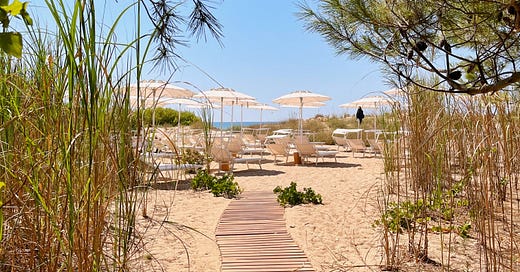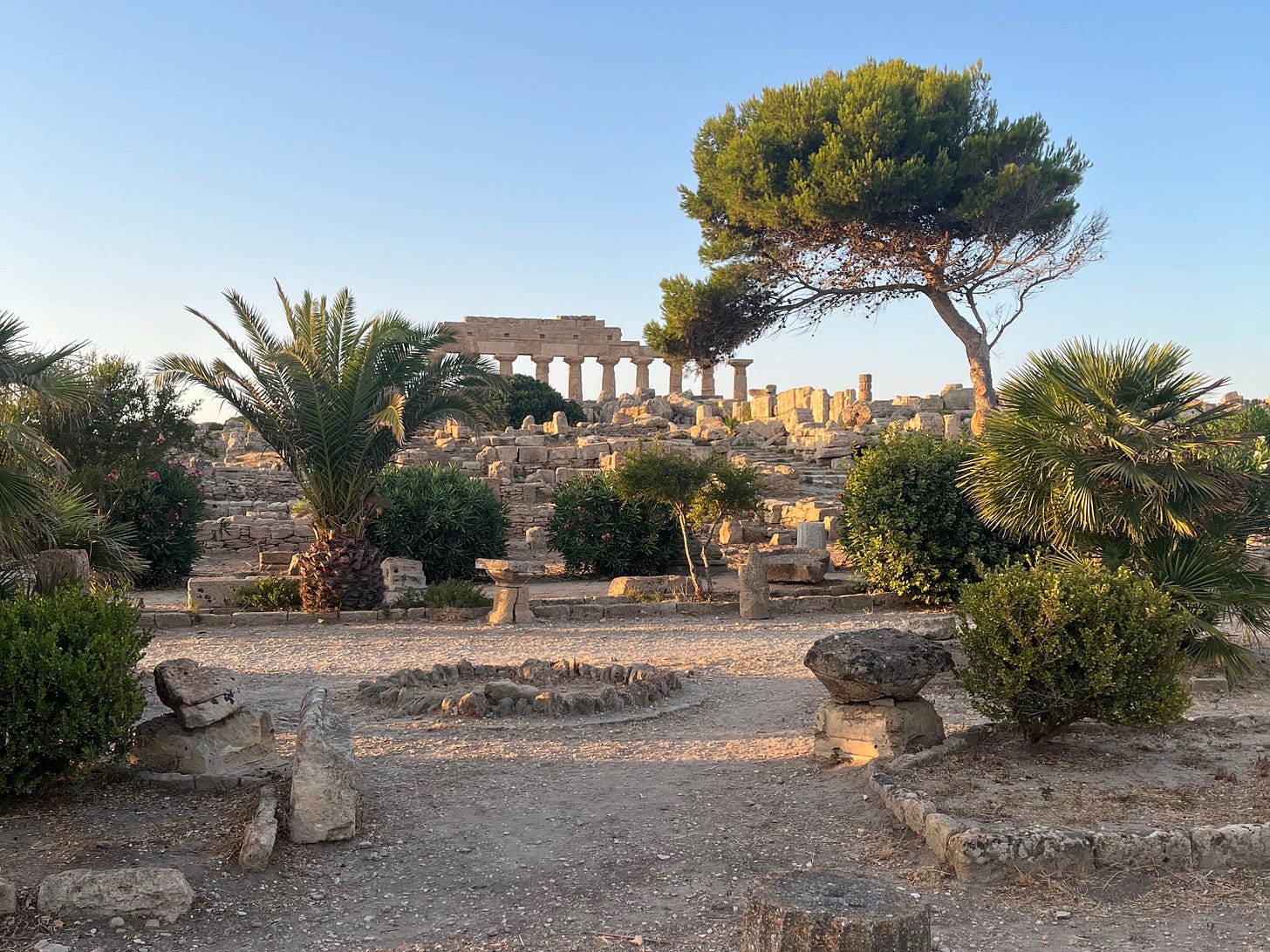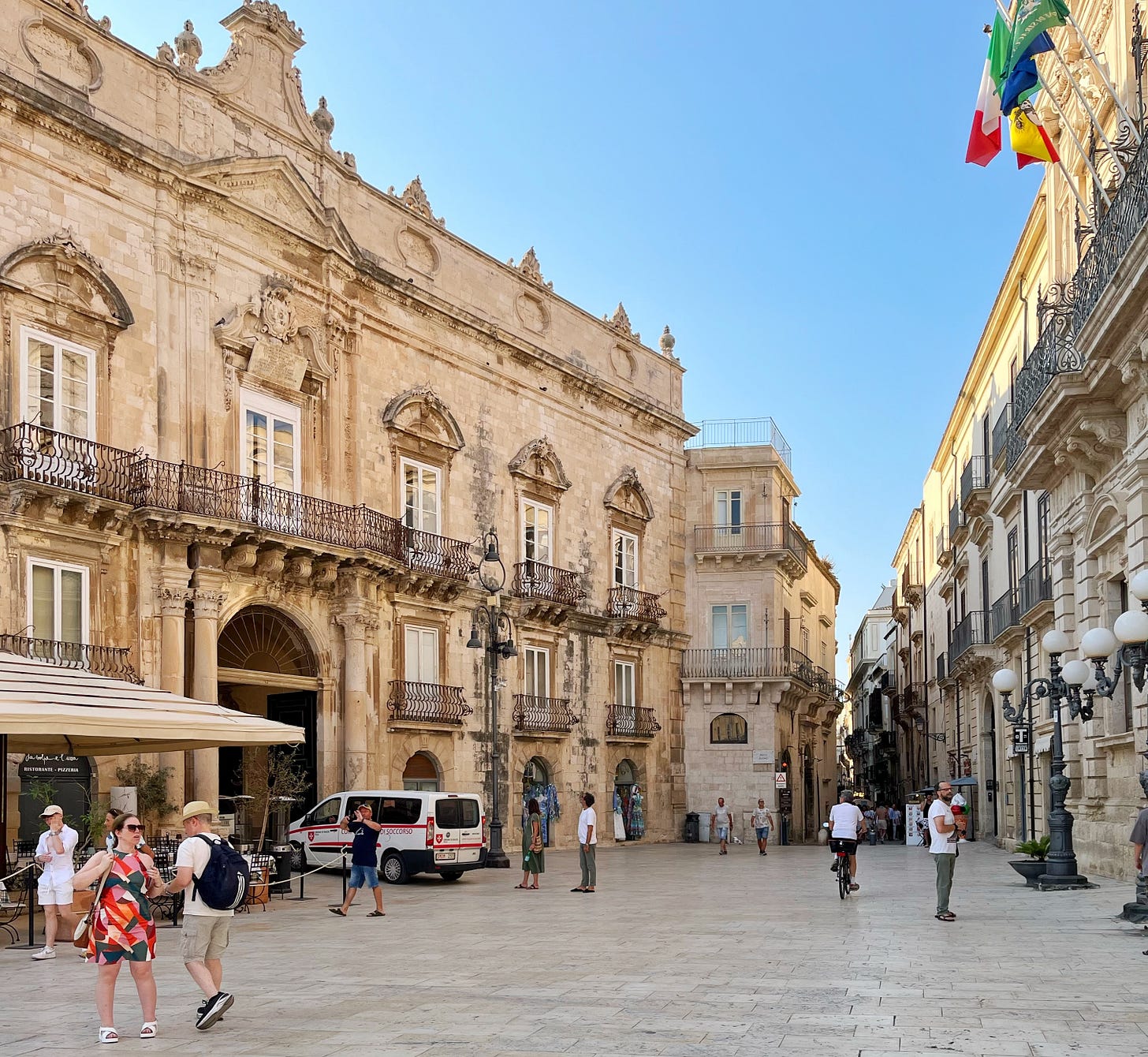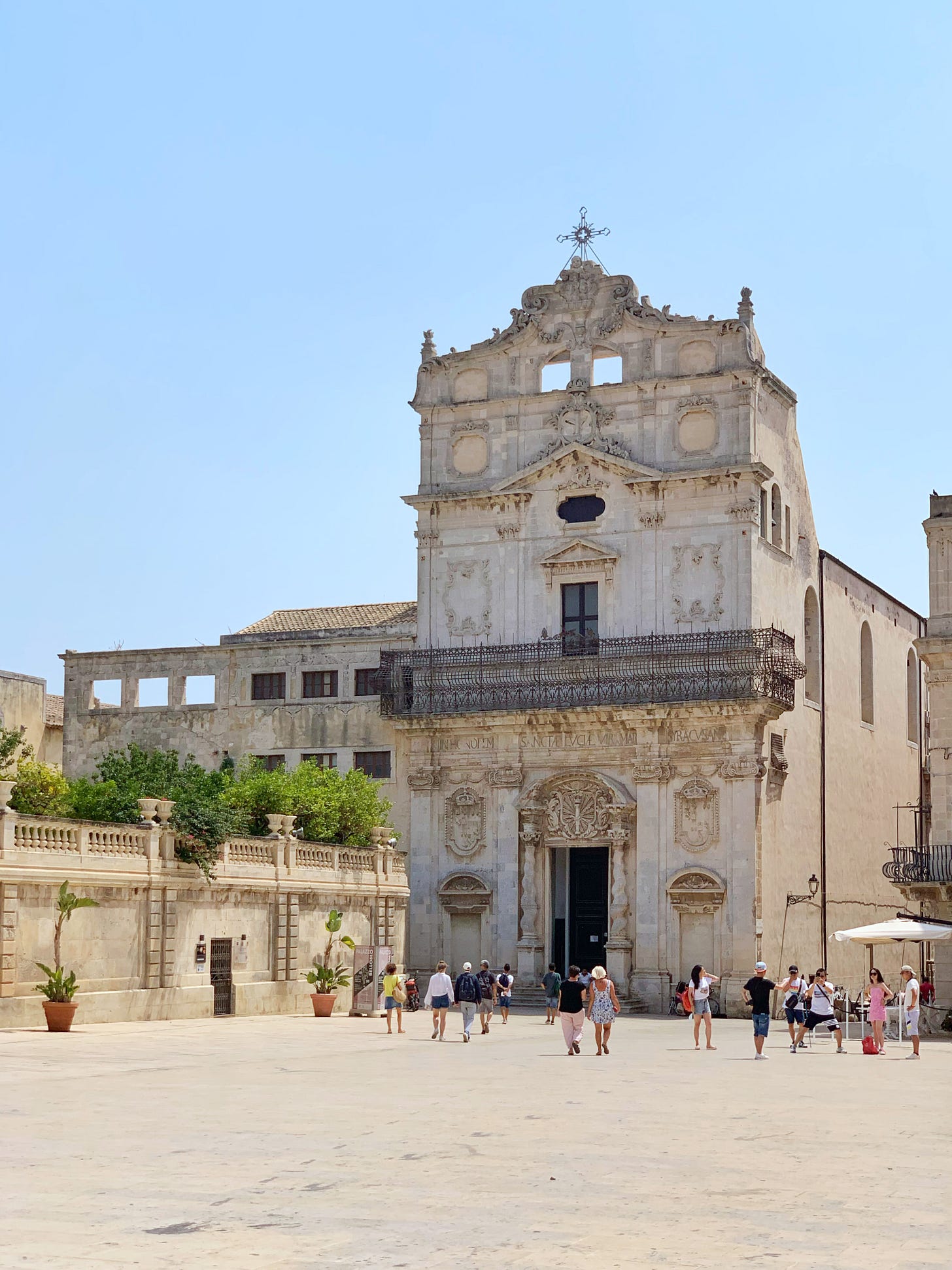Whenever someone asks me about my favorite place in Italy—aside from Rome, of course—my answer is Sicily. If I could, I would spend a month or two there every year. Sicily is not only the largest island in Italy, it’s the largest island in the Mediterranean, so it’s impossible to see it all on one trip. It’s a destination that truly has something for everyone: big bustling cities and charming little villages, fantastic beaches, rugged countryside, archeological sites, vineyards, and volcanoes. It even has its own satellite islands.
A reader recently wrote to me: “I’m looking at planning a one-month trip to Sicily in October, specifically looking at staying in Palermo, Siracusa/Ortigia & Modica with some day trips mixed in. I read your article ‘Sicily and the White Lotus Effect’ but I wondered if you have any articles and/or guides for Sicily?”
Let me say, first of all, that I applaud the plan to spend a month in Sicily. There’s so much to see and do, you certainly won’t have trouble filling your days. Plus, spending a month allows you to slow down and get a more local experience on the island.
For my honeymoon in 2021, my husband Marco and I spent two weeks in Sicily, with a week on the western side of the island and a week on the eastern side, and I still felt like we just scratched the surface on that trip. I had been prior to that and have returned a few times since, so I’ll share my tips here.
A good place to start is Palermo, the capital, which is located on the northwestern side of the island. With a population of 850,000 people, it’s the island’s largest and most dynamic city, and unlike some of Sicily’s beach towns, it’s a year-round destination.
Founded by the Phoenicians, it has been ruled by the Romans, Byzantines, Arabs, Normans, French, and Spanish before becoming part of the unified country of Italy, so the city has been a melting pot of different cultures and cuisines for centuries. Don’t miss the dazzling Byzantine mosaics in the Cappella Palatina inside the Palazzo dei Normanni; the Quattro Canti, the crossroads where four neighborhoods meet; and the outdoor markets like Ballarò and Vucciria.
From Palermo, there are a number of places you can reach within an hour or two, like San Vito Lo Capo and the Zingaro Nature Reserve (for incredible beaches and hiking); Marsala (home of the fortified wine and natural salt pans that you can visit); Agrigento (this year’s Italian capital of culture, best known for the Valley of the Temples) and the Scala dei Turchi (a terraced cliff of white marl rock).
If you want to get really off the beaten path, go to Menfi for pristine, uncrowded beaches and wineries and nearby Selinunte, where you can visit Greek temples that are less crowded than the ones in Agrigento. You can also hop on a quick flight to Pantelleria, the volcanic island where some incredible wines are produced through heroic agriculture.
On the eastern side of the island, Ortigia is my favorite place to stay, though Noto is also a good choice. On our honeymoon, Marco and I spent a week based in Noto and took day trips to Ortigia, Marzamemi, and the beaches around there before driving up to Taormina for a night. Last summer, we stayed in Ortigia for a few nights and went to Catania for dinner one evening.
Ortigia is technically part of the city of Siracusa, but it’s actually a tiny island separated from the city by a couple of bridges. It’s one of Sicily’s most beautiful Baroque cities, which were rebuilt in the prevailing style of the time after a devastating earthquake in 1693.
Wandering around Ortigia, you can admire the Duomo and the Church of Santa Lucia alla Badia, shop in the boutiques on narrow pedestrian streets like Via Roma, and see the Fonte Aretusa, a natural spring where papyrus grows. Because of the limestone used to construct the buildings, the whole centro storico has a golden hue, which is especially enchanting at sunset.
Noto, along with several other towns in the Val di Noto, was also rebuilt in the Baroque style after the earthquake. On summer evenings, the town empties out during the day while everyone is at the beach, then livens up in the evening, as people go for a stroll along Corso Vittorio Emanuele, the main street that cuts through the center of town and is lined with little shops and cafes, including Caffè Sicilia, which is famous for its granita and other desserts.
The same goes for Marzamemi, a charming little fishing village that looks like a town in the Greek islands. You could also visit Modica (known for chocolate) and Ragusa, which I quickly passed through but haven’t spent much time in.
If you’re planning to travel around or take lots of day trips to different towns, it’s a good idea to rent a car. The Frecciarossa high-speed trains don’t operate in Sicily and it can be a pain to rely on regional trains. While I wouldn’t recommend driving in big cities like Palermo and Catania, which are full of restricted zones, you’ll need a car if you want to get off the beaten path and visit beaches and wineries in the countryside.

I’d be remiss to write about why you should visit Sicily without mentioning the incredible food and wine. Some of the most famous Italian foods hail from Sicily, including arancine, caponata, cannoli, cassata, granita, and possibly eggplant parmigiana (its origins are debated).
And while you should absolutely eat all of these things in Sicily, there are many other less famous regional specialties, such as panelle (fried chickpea pancakes that make the perfect snack or appetizer), pesto trapanese (a tomato-and-almond pesto from Trapani), pasta alla norma (pasta with eggplant, tomato sauce, and ricotta salata), and the little red shrimps from Mazara del Vallo, plus anything with pistachios and almonds, both of which grow on the island.
Sicily also produces some fantastic wines in vineyards across the island, from the slopes of Mount Etna to the area around Menfi and the satellite islands of Pantelleria and Salina. If you go, be sure to try wines made with local grape varieties like Grillo, Catarrato, and Nerello Mascalese, as well as passito di Pantelleria (a sweet dessert wine with notes of apricot and honey). Last year, I did a tour and tasting at Mandrarossa in Menfi and visited three of the estates of Donnafugata, one of the island’s leading wineries. In the future, I hope to visit Planeta and Marco De Bartoli’s wineries.
I could go on and on about Sicily and how incredible it is—and will dedicate future issues of the New Roman Times to various cities and towns—but I want to know what you think about the island. Have you been to Sicily? If so, where and what was your experience like? What else do you want to learn about the island?
Further Reading
You can read my aforementioned piece about Sicily and the White Lotus effect here.
I also wrote this piece about where else to go in Sicily if you liked the White Lotus for AFAR.
I wrote a personal feature about my honeymoon, which appeared in the February 2022 issue of Hemispheres, which unfortunately is no longer available online, but if you ask, I’ll email you the PDF.
I wrote “The Fodor’s Five” things to know about Sicily and you can find lots more information by poking around Fodors.com.
My recent guide to Palermo for Travel + Leisure includes tips from local experts Salvatore Spatafora and Linda Sarris, who I interviewed in this issue of the New Roman Times.
Following my trip to Pantelleria with Donnafugata, I wrote about the island’s heroic viticulture for Food & Wine and wrote this guide to the island for Travel + Leisure. You can also read my interview with Josè Rallo, CEO of Donnafugata, here.
I included Menfi in my latest article for AFAR, a roundup of 7 beautiful places in Italy without the crowds.
You can see all of the New Roman Times’ coverage of under-the-radar destinations here.













I love this and your photos. Strangely it's part of Italy I didn't love when I went a long long time ago - so this piece makes me want to go back and explore it again with fresh eyes and do more of the southern part of the island and the wine scene. We stayed in Palermo a few days, and visited Cefalu on a day trip (which I loved) but Palermo wasn't for me.
We were based in CataniIa for a month a couple of years ago and fell head over heels with that city, Palermo, Taormina and Noto as you can read in the Nomad Foodies archive.
Planning our next visit in September arriving by train in Messina from Naples...